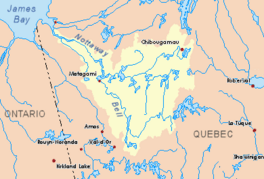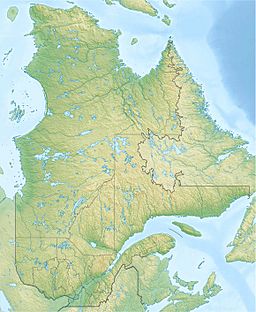Opawica Lake facts for kids
Quick facts for kids Opawica Lake |
|
|---|---|

Watershed of Nottaway River
|
|
| Location | Eeyou Istchee Baie-James (municipality) |
| Coordinates | 49°36′56″N 75°56′52″W / 49.61556°N 75.94778°W |
| Type | Lake of dam |
| Primary inflows |
|
| Primary outflows | Opawica River |
| Basin countries | Canada |
| Max. length | 17.1 kilometres (10.6 mi) |
| Max. width | 7.3 kilometres (4.5 mi) |
| Surface elevation | 301 metres (988 ft) |
Opawica Lake is a freshwater lake in Quebec, Canada. It is located in the southern part of the Eeyou Istchee James Bay area. The Opawica River flows right through it.
The main activity around the lake is forestry, which means cutting down trees for wood. Tourism is also popular. You can boat for about 22.1 kilometres (13.7 mi) on the lake, going around Opawica Island. The lake was formed when the Opawica River widened, and there is a dam at its end.
You can reach the lake by forest roads. Route 113 connects to the northern and western parts. Another forest road goes around the southern, eastern, and northern shores. A railway also passes between Opawica Lake and Wachigabau Lake.
The lake usually freezes over from early November to mid-May. It's generally safe to walk on the ice from mid-November to mid-April.
Contents
Exploring Opawica Lake
Opawica Lake is 17.1 kilometres (10.6 mi) long and 7.3 kilometres (4.5 mi) wide at its widest point. It sits at an elevation of 301 metres (988 ft) above sea level. The lake's shape looks a bit like an ax, with the sharp part pointing north.
Islands and Features
Opawica Island is in the western part of the lake. It is 3.6 kilometres (2.2 mi) long and almost round. This island has a mountain peak that is 360 metres (1,180 ft) high. It takes up a lot of space in that part of the lake.
The eastern part of the lake is narrow and long, stretching for 11.6 kilometres (7.2 mi). It collects water from Dalime Creek, which flows from the north.
River Connections
The Opawica River starts at Gabriel Lake. It flows northwest, passing through Lichen Lake and Wachigabau Lake. Then, it enters Opawica Lake at two spots, on either side of Gull Island.
Gull Island is 5.1 kilometres (3.2 mi) long and 1.5 kilometres (0.93 mi) wide. This island, along with two peninsulas, forms a long strip of land. This strip is 14.6 kilometres (9.1 mi) long and runs along the Canadian National Railway.
Lake's Location
The dam at the end of Opawica Lake is in a bay on the north side of the western part of the lake. Here are some distances from the dam:
- 8.5 kilometres (5.3 mi) south of where the Opawica River ends.
- 30.0 kilometres (18.6 mi) northeast of Lake Waswanipi.
- 9.3 kilometres (5.8 mi) south of the village of Waswanipi.
- 74.9 kilometres (46.5 mi) east of the mouth of Goéland Lake (Waswanipi River).
- 284.8 kilometres (177.0 mi) southeast of the mouth of the Nottaway River.
- 125.2 kilometres (77.8 mi) east of downtown Matagami.
- 116.3 kilometres (72.3 mi) southwest of downtown Chibougamau.
Surrounding Waterways
The main rivers and lakes near Opawica Lake include:
- North: Opawica River, Chibougamau River, Waswanipi River.
- East: Opawica River.
- South: Wachigabau Lake, Opawica River, Lichen Lake, Nicobi River.
- West: Bachelor River, Lake Waswanipi.
After leaving Opawica Lake's dam, the Opawica River flows for about 14 kilometres (8.7 mi). It first goes northeast, then turns northwest. It then meets the Chibougamau River. When these two rivers join, they form the beginning of the Waswanipi River.
The Name Opawica
The name "Opawica" has been used for a long time. On a map from 1900, it was called "Opawakow Sagagan Gold Sandy Point L." This map was made by Henry O'Sullivan after his explorations.
The name is also in a 1925 book called "Dictionary of Rivers and Lakes of the Province of Quebec." The word "Opawica" comes from the Cree language. It means "there is a pass" or "a narrowing between sandbanks."
The official name "Lake Opawica" was made formal on December 5, 1968. This was when the Commission de toponymie du Québec (Quebec's place name commission) was created.


